Thibault Castells
EdgeFusion: On-Device Text-to-Image Generation
Apr 18, 2024Abstract:The intensive computational burden of Stable Diffusion (SD) for text-to-image generation poses a significant hurdle for its practical application. To tackle this challenge, recent research focuses on methods to reduce sampling steps, such as Latent Consistency Model (LCM), and on employing architectural optimizations, including pruning and knowledge distillation. Diverging from existing approaches, we uniquely start with a compact SD variant, BK-SDM. We observe that directly applying LCM to BK-SDM with commonly used crawled datasets yields unsatisfactory results. It leads us to develop two strategies: (1) leveraging high-quality image-text pairs from leading generative models and (2) designing an advanced distillation process tailored for LCM. Through our thorough exploration of quantization, profiling, and on-device deployment, we achieve rapid generation of photo-realistic, text-aligned images in just two steps, with latency under one second on resource-limited edge devices.
LD-Pruner: Efficient Pruning of Latent Diffusion Models using Task-Agnostic Insights
Apr 18, 2024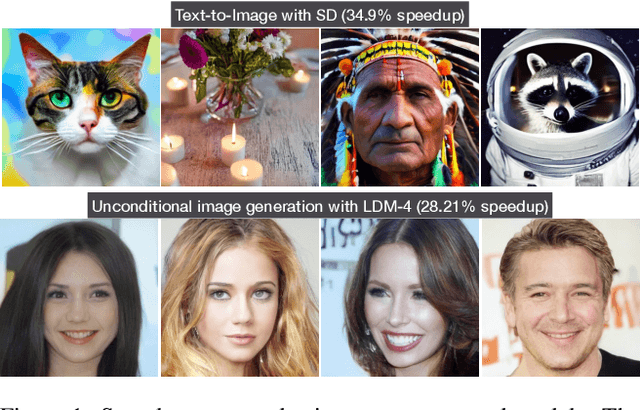
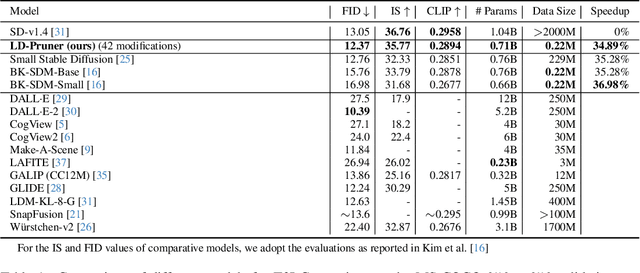


Abstract:Latent Diffusion Models (LDMs) have emerged as powerful generative models, known for delivering remarkable results under constrained computational resources. However, deploying LDMs on resource-limited devices remains a complex issue, presenting challenges such as memory consumption and inference speed. To address this issue, we introduce LD-Pruner, a novel performance-preserving structured pruning method for compressing LDMs. Traditional pruning methods for deep neural networks are not tailored to the unique characteristics of LDMs, such as the high computational cost of training and the absence of a fast, straightforward and task-agnostic method for evaluating model performance. Our method tackles these challenges by leveraging the latent space during the pruning process, enabling us to effectively quantify the impact of pruning on model performance, independently of the task at hand. This targeted pruning of components with minimal impact on the output allows for faster convergence during training, as the model has less information to re-learn, thereby addressing the high computational cost of training. Consequently, our approach achieves a compressed model that offers improved inference speed and reduced parameter count, while maintaining minimal performance degradation. We demonstrate the effectiveness of our approach on three different tasks: text-to-image (T2I) generation, Unconditional Image Generation (UIG) and Unconditional Audio Generation (UAG). Notably, we reduce the inference time of Stable Diffusion (SD) by 34.9% while simultaneously improving its FID by 5.2% on MS-COCO T2I benchmark. This work paves the way for more efficient pruning methods for LDMs, enhancing their applicability.
Shortened LLaMA: A Simple Depth Pruning for Large Language Models
Feb 05, 2024Abstract:Structured pruning of modern large language models (LLMs) has emerged as a way of decreasing their high computational needs. Width pruning reduces the size of projection weight matrices (e.g., by removing attention heads) while maintaining the number of layers. Depth pruning, in contrast, removes entire layers or blocks, while keeping the size of the remaining weights unchanged. Most current research focuses on either width-only or a blend of width and depth pruning, with little comparative analysis between the two units (width vs. depth) concerning their impact on LLM inference efficiency. In this work, we show that a simple depth pruning approach can compete with recent width pruning methods in terms of zero-shot task performance. Our pruning method boosts inference speeds, especially under memory-constrained conditions that require limited batch sizes for running LLMs, where width pruning is ineffective. We hope this work can help deploy LLMs on local and edge devices.
On Architectural Compression of Text-to-Image Diffusion Models
May 25, 2023Abstract:Exceptional text-to-image (T2I) generation results of Stable Diffusion models (SDMs) come with substantial computational demands. To resolve this issue, recent research on efficient SDMs has prioritized reducing the number of sampling steps and utilizing network quantization. Orthogonal to these directions, this study highlights the power of classical architectural compression for general-purpose T2I synthesis by introducing block-removed knowledge-distilled SDMs (BK-SDMs). We eliminate several residual and attention blocks from the U-Net of SDMs, obtaining over a 30% reduction in the number of parameters, MACs per sampling step, and latency. We conduct distillation-based pretraining with only 0.22M LAION pairs (fewer than 0.1% of the full training pairs) on a single A100 GPU. Despite being trained with limited resources, our compact models can imitate the original SDM by benefiting from transferred knowledge and achieve competitive results against larger multi-billion parameter models on the zero-shot MS-COCO benchmark. Moreover, we demonstrate the applicability of our lightweight pretrained models in personalized generation with DreamBooth finetuning.
Automatic Neural Network Pruning that Efficiently Preserves the Model Accuracy
Nov 18, 2021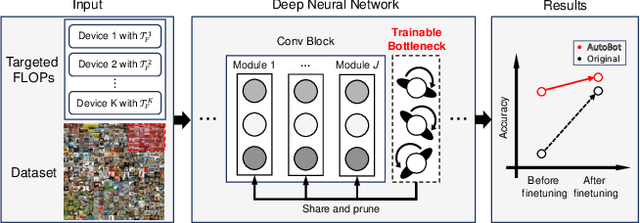
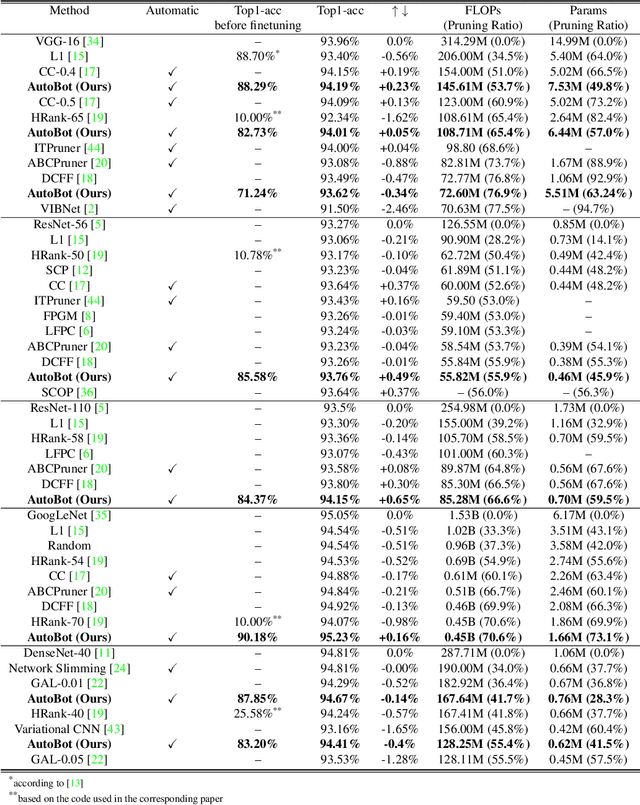

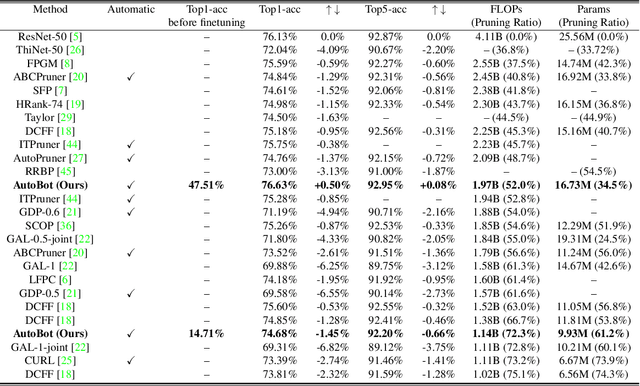
Abstract:Neural networks performance has been significantly improved in the last few years, at the cost of an increasing number of floating point operations per second (FLOPs). However, more FLOPs can be an issue when computational resources are limited. As an attempt to solve this problem, pruning filters is a common solution, but most existing pruning methods do not preserve the model accuracy efficiently and therefore require a large number of finetuning epochs. In this paper, we propose an automatic pruning method that learns which neurons to preserve in order to maintain the model accuracy while reducing the FLOPs to a predefined target. To accomplish this task, we introduce a trainable bottleneck that only requires one single epoch with 25.6% (CIFAR-10) or 7.49% (ILSVRC2012) of the dataset to learn which filters to prune. Experiments on various architectures and datasets show that the proposed method can not only preserve the accuracy after pruning but also outperform existing methods after finetuning. We achieve a 52.00% FLOPs reduction on ResNet-50, with a Top-1 accuracy of 47.51% after pruning and a state-of-the-art (SOTA) accuracy of 76.63% after finetuning on ILSVRC2012. Code is available at (link anonymized for review).
 Add to Chrome
Add to Chrome Add to Firefox
Add to Firefox Add to Edge
Add to Edge